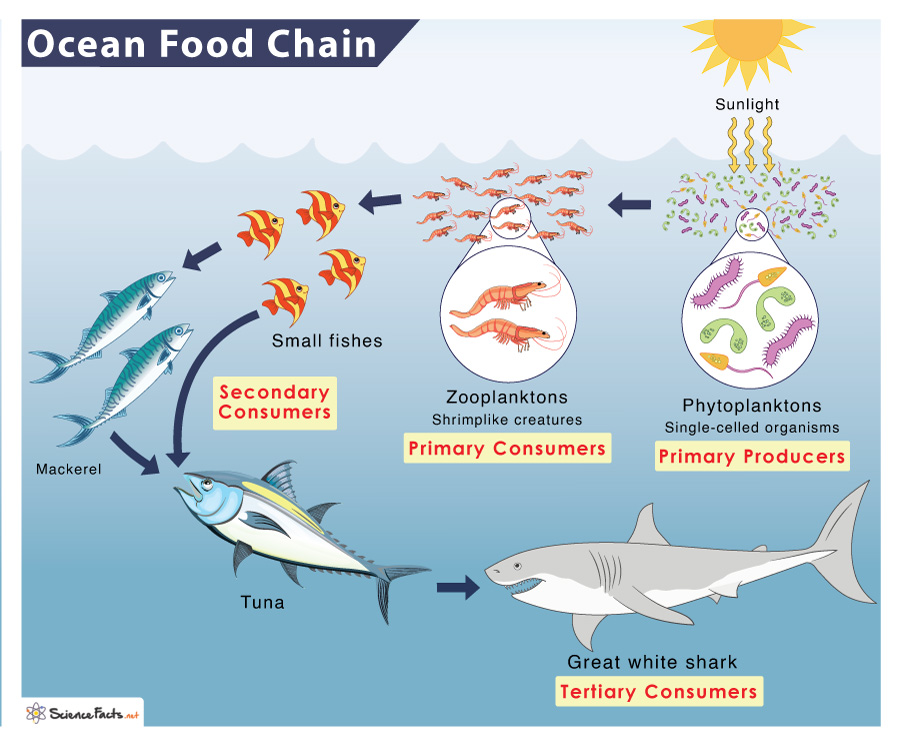Ocean Food Chain
The ocean or marine food chain shows the relationship among the organisms living in the ocean. Since organisms live underwater, they differ from those dwelling in terrestrial environments. Food chains are different from one oceanic environment to another.
The marine biome is the largest worldwide, covering three-quarters of the Earth’s surface. About 15% of all the species living on Earth, containing almost 300,000 species, are marine dwellers. The marine ecosystem consists of a series of interconnected producers and consumers.
Example
A typical example of the ocean food chain is sharks eating tunas, which eat small fish. The small fishes consume plankton and crustacean, which feed on the microscopic, single-celled organism.
Like terrestrial food chains, the primary ocean food chain also has different levels.
Level 1: Primary Producers (Photoautotrophs)
They form the foundation of the ocean food chain. Producers in the ocean food chain are mostly invisible, although they are great in numbers. They are one-celled organisms called phytoplanktons that cover the ocean’s upper layer. Some photoautotrophic bacteria capture the sun’s energy to produce food by photosynthesis. In the coastal areas, seaweeds and grasses also perform the same function.
Together these compounds play a significant role in producing food that sustains the entire ocean’s food chain. They also contribute more than half of the oxygen we breathe.
Level 2: Primary Consumers (Herbivores)
The second food chain level consists of groups that feed on photoautotrophs for food. In their larval stages, microscopic animals called zooplankton include jellyfish, crustaceans, and mollusks. Larger herbivores include larger fishes like surgeonfish, parrotfish, and green turtles.
Although small, herbivores are significant eaters in the food chain, only to be eaten by the succeeding food chain elements, the carnivores.
Level 3: Secondary Consumers (Carnivores)
The zooplankton of level two sustains a diverse group of small carnivores such as sardines, herring, and menhaden. Secondary consumers include larger carnivores such as octopuses, feeding on crabs and lobsters, and fishes feeding on invertebrates.
Although they successfully catch prey, they also fall prey to the animals in the next level of the food chain – the tertiary consumers also called the predators.
Level 4: Tertiary Consumers (Top Predators)
They reside at the top of the food chain of the ocean. Tertiary consumers are enormous and fast-moving animals well-adapted to catch their prey. Top predators generally have an extensive lifespan, higher generation time, and lower reproduction rates. Such organisms include sharks, tunas, dolphins, penguins, seals, and walruses.
Thus, protecting these groups of animals is extremely important as their numbers are often slow to rebound and can affect the balance of the entire food chain.
Although predators reside at the topmost level of the ocean food chain, they are not safe from the ultimate predators – humans.
Alternative Ocean Food Chains
The primary ocean food chain based on plant productivity constitutes the majority of organisms in such ecosystems. However, other marine ecosystems also exist entirely independent of sunlight. The primary producers of such ecosystems are chemoautotrophs that use chemical energy to prepare food. Chemoautotrophic bacteria in the seafloor of hydrothermal vent ecosystems are a classic example.
Food chains also vary from one oceanic environment to another. The weather and climate differ from one geographic location to another. Accordingly, there are five leading ocean food chains in the marine biome:
- Coral Reef Food Chain in the coral reefs is located mainly near the equator, where the water is warm, and the environment is tropical.
- Arctic Ocean Food Chain is found in the Arctic Ocean in the polar circle of the northern hemisphere. The weather there is cold enough even to reach the sub-zero level.
- Atlantic Ocean Food Chain is located in the Atlantic Ocean. It is the second-largest of all oceans in the world and is home to billions of marine organisms.
- Pacific Ocean Food Chain in the pacific is the largest ocean ecosystem in the world. Some of the areas of the ecosystem are the most productive in the world and home to thousands of species not found elsewhere.
- The Southern Ocean, popularly known as the Antarctic Ocean, encircles Antarctica. It is home to marine life, like whales, penguins, and seals.
-
References
Article was last reviewed on Friday, February 17, 2023




